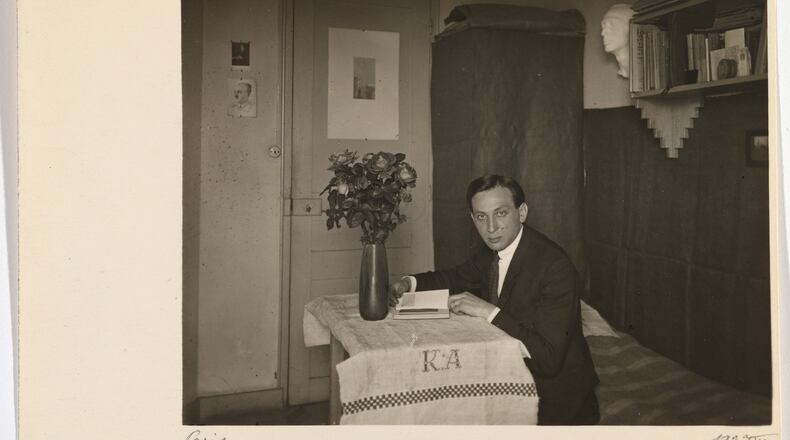An immigrant story of a talented Hungarian photographer whose new life in Paris ignited his artistic legacy, “André Kertész: Postcards From Paris” at the High Museum is an utterly captivating window into this beloved photographer’s work.
In an art world where big is often assumed to be better in both photography and painting, Kertész’s diminutive cartes postales prints made on inexpensive postcard paper illustrate the captivating powers of the tiny. Kertész’s often itty bitty photographs (some close to postage-stamp size) printed in such an accessible format were, the exhibition points out, also a wonderful way for the artist to take his art with him and share it with friends and family.
These diminutive works were also a unique expressive medium with Kertész perfecting techniques of cropping and framing his images against satisfying expanses of empty space. That method truly optimized the form and allowed him a mastery not unlike Warhol’s innovative use of the screenprint. “Postcards” shows a mastery of form but also of perspective in Kertész’s decidedly quirky compositions shot from above, looking down on his subjects. A profusion of staircases lend dimension, dynamism and a hint of mystery to his body of work. In scale and subject there is an intimacy to Kertész’s photographs that makes them feel remarkably timeless and personal, like viewing the world through the eyes of an immigrant ancestor with a fresh, exploratory vision.
Credit: Handout
Credit: Handout
Following the photographer’s progress from his origins in Hungary, this marvelous traveling exhibition, curated by Elizabeth Siegel at the Art Institute of Chicago, shows the development of Kertész’s art in Paris. Beginning with his emigration in 1925, Kertész worked alongside a cadre of fellow Hungarian artists and expats. It was a thriving bohemian scene united, in many instances, by their shared emigre status and the unique circumstance of being an artist. There’s no better proof of that creative stew pot than Kertész’s images of his fellow artists: dancers, sculptors, writers and painters including writer Paul Dermée, German sculptor Anne-Marie Merkel, poet Tristan Tzara and, most famously, painter Piet Mondrian. Kertész undeniably ran with a cool crowd. His portraits of the women artists in his circle are especially delightful. Modern, sexy and intelligent, those images elevate women to the plane of artist rather than consigning them to the traditional empty vessel role as muse. He captured female beauty, but also something rarer. He captured character, as in an image of dancer Magda Förstner contorting her body into serpentine forms in one of Kertész’s most famous images, “Satiric Dancer” (1927).
Credit: Handout
Credit: Handout
With their fresh, improvisational feel and small format, it is hard not to think of contemporary selfies and Instagram when looking at works like a portrait of Kertész with journalist Jean Jaffe and artist Frantisek Reichentál from 1926. The exhibition focuses on Kertész’s use of this format until 1928 and this, as Siegel puts it, “gestational” period in his career. It’s a moment that yielded iconic images like “Fork” (1928) which used an economical arrangement of objects to create a sublimely modernist moment.
Credit: Canadian Photography Institute (CPI). National Gallery of Canada
Credit: Canadian Photography Institute (CPI). National Gallery of Canada
Kertész was also a street photographer and a ride-or-die Francophile who conveyed how profoundly place and identity can become emotionally enmeshed. “Paris accepted me as an artist,” he said of that formative relationship. Kertész captured the extremes of city life in a homeless man wandering its lonely boulevards in “Sécurité” (1927), where his juxtaposition of bellowing advertisements and human beings can recall Walker Evans at his most melancholy. In a more glamorous vision of his adopted home, the Eiffel Tower is glimpsed like a beckoning lighthouse through a romantic, velvety darkness in “Eiffel Tower at Night” (1927).
The show concludes with another exodus, of Kertész to Manhattan in 1936 where he reinvented himself yet again. He eventually adopted another accessible and portable medium, the Polaroid (a gift from musician Graham Nash of Crosby, Stills and Nash). It was a mode defined by what curator Siegel describes as “restricted dimensions” like the carte postale and Kertész used it to distract himself after his wife’s death and continue his exploratory work.
VISUAL ART REVIEW
“André Kertész: Postcards From Paris”
Through May 29. 10 a.m.-5 p.m. Tuesdays-Saturdays; noon-5 p.m. Sundays. $16.50, ages 6 and older; free for children 5 and younger and members. High Museum of Art, 1280 Peachtree St. NE, Atlanta. 404-733-4444, high.org.
Bottom line: A way to ponder a photographic master in a new light, this exhibit of André Kertész’s rare carte postale work is a deeply satisfying, intimate plunge into the development of a singular artistic vision.
About the Author
Keep Reading
The Latest
Featured




